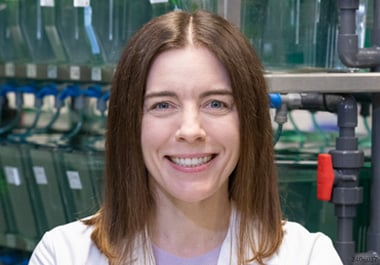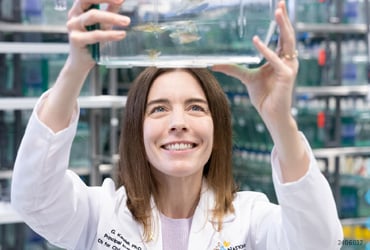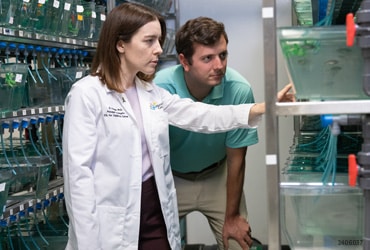From a QuadW-AACR Sarcoma Research Fellowship to an Independent Career
By Laura Romano, PhD

Genevieve Kendall, PhD, has long been interested in pediatric diseases. Her interest began during her doctoral studies, where she identified and repurposed an FDA-approved drug to treat Duchenne muscular dystrophy, a lethal muscle-wasting disease. Building on her knowledge of skeletal muscle biology, Dr. Kendall began a postdoctoral fellowship at the University of Texas Southwestern Medical Center under the mentorship of James Amatruda, MD, PhD, where she studied rhabdomyosarcoma (RMS), a type of soft tissue sarcoma that has molecular features of immature skeletal muscle.
Though a rare type of cancer, RMS is the most common soft tissue sarcoma in children, accounting for nearly half of all pediatric soft tissue sarcoma cases (1). Histologically, a key characteristic of RMS tumors is the presence of undifferentiated embryonic skeletal muscle cells, indicating a failure to terminally differentiate. Survival rates have improved for localized cases of RMS, but rates for metastatic RMS remain low, with overall survival rates around 25% (1).
It was at the beginning of her postdoctoral fellowship that Dr. Kendall received the 2015 QuadW Foundation-AACR Fellowship for Clinical/Translational Sarcoma Research. “I was new to cancer research as a postdoctoral fellow, but this fellowship firmly integrated me into the pediatric cancer community, and more broadly, the cancer research community,” Dr. Kendall shared.

Fusion-positive RMS is a particularly aggressive type of RMS (2). Dr. Kendall’s project, titled “Zebrafish modeling of PAX3-FOXO1 driven rhabdomyosarcoma,” sought to generate a zebrafish model of RMS that harbored the human PAX3-FOXO1 fusion oncogene. Thus, this animal model that recapitulates this aggressive type of RMS offers opportunities to better understand fusion-positive RMS biology and design therapeutics targeting the disease’s underlying genetics, the latter of which is currently lacking for fusion-positive RMS patients. However, as Dr. Kendall noted, “It is traditionally very challenging to receive funding to create new animal models and I appreciate the review committee for recognizing the potential impact.”
Dr. Kendall was awarded the QuadW-AACR Fellowship and used the funds to generate the PAX3-FOXO1 RMS zebrafish model. “This was the first evidence that human PAX3-FOXO1 could generate tumors in zebrafish that recapitulated the human disease,” Dr. Kendall explained. A key finding from the work was that the aberrant PAX3-FOXO1 transcription factor uniquely upregulated her3 expression, among other genes (3). Further studies demonstrated that HES3, the human ortholog to her3, inhibited myogenesis in the zebrafish models, causing muscle cells to remain in a more primitive state, which mirrored the failed skeletal muscle differentiation in RMS. Moreover, it was found that HES3 was overexpressed in fusion-positive RMS and associated with reduced overall survival (3).
In addition to identifying HES3 as a cooperating gene in the pathogenesis of RMS, the PAX3-FOXO1 zebrafish model also provided Dr. Kendall with invaluable skills that continue in her independent research program today. “The strategy that I refined over the process of developing this model has been foundational to generating new zebrafish models in my lab, including the VGLL2-NCOA2 fusion for infantile rhabdomyosarcoma,” Dr. Kendall explained.

“With the support of my mentor, and the data, publications, and new ideas generated from this grant, I was competitive for assistant professor positions,” she said.
In 2019, Dr. Kendall started her independent research program at Nationwide Children’s Hospital and The Ohio State University, where she holds appointments as a Principal Investigator and a tenure-track Assistant Professor, respectively. Her independent research program focuses on developing cross-species comparative oncology models to understand pediatric fusion-positive sarcoma biology and identify therapeutic strategies.
“The overarching strategy that was developed for generating the PAX3-FOXO1 zebrafish model was the basis for papers and competitive grant applications as an independent investigator, including an Alex’s Lemonade Stand Foundation ‘A’ Award, a V Foundation Scholar Award, and my first R01 from the National Cancer Institute,” Dr. Kendall said. She further discussed that “the strategies used to develop the PAX3-FOXO1 zebrafish model have supported collaborations with clinical sequencing efforts to make personalized medicine zebrafish models of rare pediatric sarcoma fusion oncogenes.”
In the long-term, Dr Kendall explained that her goal is to “integrate vertebrate zebrafish, mouse, and cell culture models with patient samples to identify conserved genetic programs for RMS tumorigenesis and novel therapeutic strategies.” Speaking more broadly about the future of pediatric sarcomas research, Dr. Kendall shared that her vision is to “fully leverage our understanding of the genetics of the disease, and the influence of developmental context, to identify tailored targeted therapies and help children with cancer.”

References
- Skapek SX, Ferrari A, Gupta AA, Lupo PJ, Butler E, Shipley J, et al. Rhabdomyosarcoma. Nat. Rev. Dis. Primers. 2019;5:1. doi: 10.1038/s41572-018-0051-2.
- Sorensen PHB, Lynch JC, Qualman SJ, Tirabosco R, Lim JF, Maurer HM, et al. PAX3-FKHR and PAX7-FKHR gene fusions are prognostic indicators in alveolar rhabdomyosarcoma: a report from the children’s oncology group. J. Clin. Oncol. 2002;20:2672-9. doi: 10.1200/JCO.2002.03.137.
- Kendall GC, Watson S, Xu L, LaVigna CA, Murchison W, Rakheja D, et al. PAX3-FOXO1 transgenic zebrafish models identify HES3 as a mediator of rhabdomyosarcoma tumorigenesis. Elife. 2018;7:e33800. doi: 10.7554/eLife.33800.